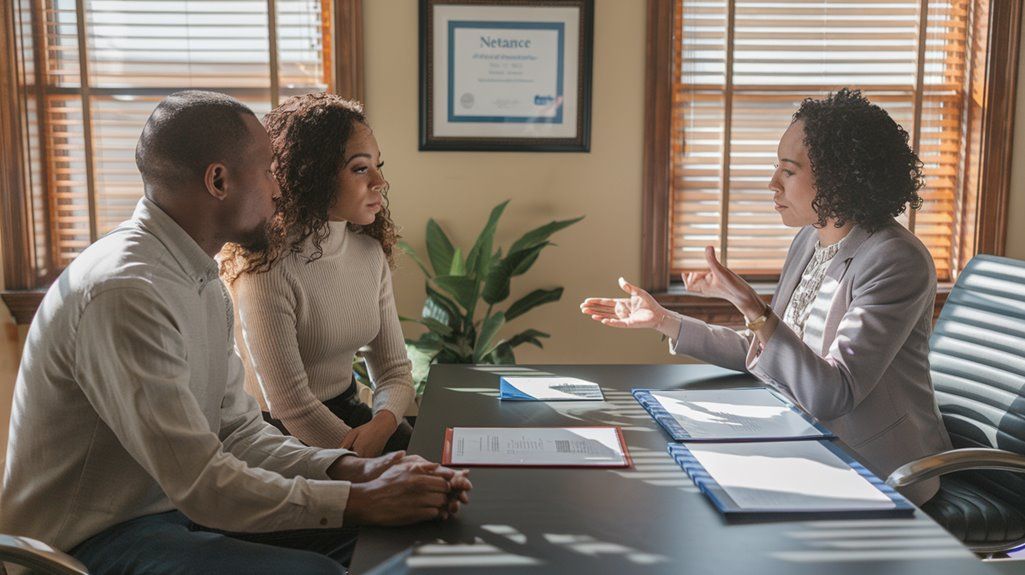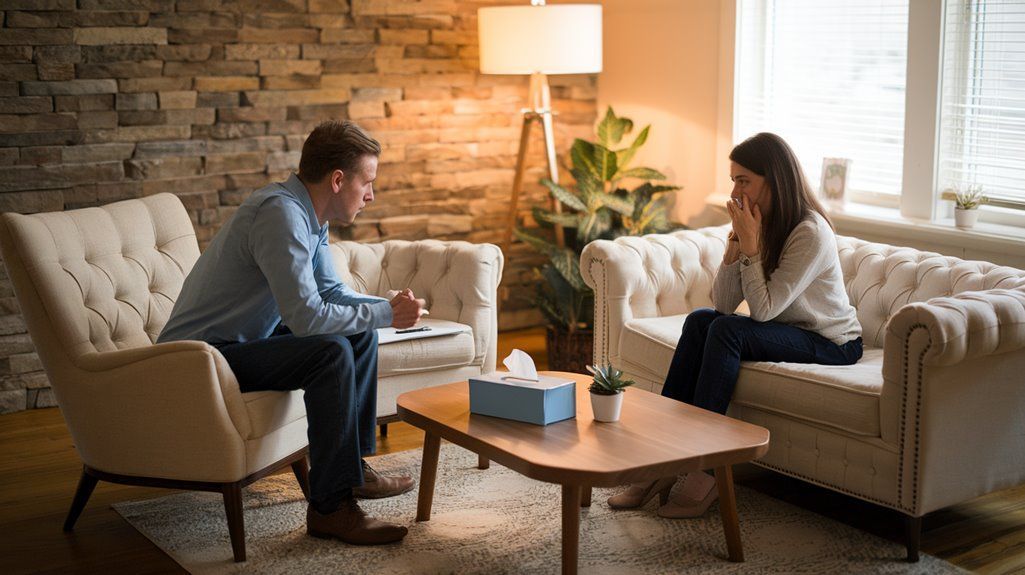How Can Family Therapy Foster a Healthier and More Supportive Home Environment?
Share this article:

Family therapy can help you build a healthier and more supportive home by improving communication skills, managing conflicts, and strengthening bonds among family members. It teaches you to listen with empathy, express thoughts and feelings constructively, and embrace conflict resolution strategies. This creates a safe space where everyone feels heard and appreciated, fostering an atmosphere of mutual respect. By encouraging positive behavior and healing emotional wounds together, family therapy empowers you to transform your home environment into a place of understanding, support, and connection. There's even more to discover on how these approaches can make a lasting difference in your family life.
Key Takeaways
- Family therapy provides a safe space to express feelings without judgment, encouraging open communication.
- It helps identify and break negative behavioral patterns, fostering a healthier home environment.
- Therapy encourages active listening and empathy, strengthening familial bonds and mutual understanding.
- Guided conflict resolution strategies turn conflicts into opportunities for growth and understanding.
- Celebrating achievements and acknowledging efforts in therapy sessions reinforces positive behavior and mutual support.
Improving Communication Skills
Building strong communication skills is the cornerstone of creating a harmonious home environment, and it's something you can start improving today. It's about more than just talking; it's about connecting with your loved ones on a deeper level, understanding their perspectives, and expressing your thoughts and feelings in a way that's respectful and constructive. You're not just sharing words; you're building bridges.
Listening is just as crucial as speaking. It's about giving your full attention, showing empathy, and acknowledging the feelings behind the words. When you listen with your heart, not just your ears, you create a safe space for openness and honesty. This doesn't mean you'll always agree, but you'll understand each other better, and that's a big step towards mutual respect and support.
Managing Family Conflicts
In every family, conflicts are inevitable, but it's how you navigate through them that can either strengthen or strain your relationships. Understandably, it's challenging to see eye to eye on every issue. However, embracing conflict resolution strategies can transform these moments into opportunities for growth.
Firstly, acknowledging each family member's feelings and perspectives is crucial. It's easy to dismiss or overlook someone's emotions, especially in the heat of the moment, but recognizing and validating these feelings can pave the way for constructive dialogue.
Active listening plays a pivotal role in managing family conflicts. This means truly hearing what your loved ones are saying, without formulating a response while they're still talking. It's about understanding their viewpoint, which can significantly reduce misunderstandings and foster a supportive atmosphere.
Setting ground rules for discussions can also help. This might include not interrupting, avoiding blame, and expressing oneself without resorting to hurtful language. Such guidelines ensure that even when disagreements arise, they're handled in a manner that respects everyone involved.
Strengthening Bonds
Strengthening family bonds isn't just beneficial; it's essential for nurturing a supportive and loving home environment. When you invest time and energy into deepening these connections, you're laying the foundation for a home filled with understanding, patience, and mutual respect. Family therapy serves as a powerful tool in this journey, providing a safe space for each member to express feelings, fears, and aspirations without judgment.
Through guided conversations, you'll discover the unique ways in which each family member experiences love and support. This understanding allows you to tailor your interactions to meet their emotional needs more effectively, fostering a sense of belonging and security. It's about learning to listen, truly listen, to what's being said beneath the words. Acknowledging each other's efforts and growth cultivates an atmosphere of appreciation and encouragement.
Encouraging Positive Behavior
You've seen how strengthening bonds can transform your home environment; now it's time to focus on encouraging positive behavior.
By reinforcing good actions and celebrating achievements together, you're not only acknowledging effort but also building a foundation of mutual respect and appreciation.
This approach fosters a supportive atmosphere where every family member feels valued and motivated to contribute positively.
Reinforcing Good Actions
Recognizing and reinforcing your family members' positive actions can significantly enhance the atmosphere of your home, making it a more nurturing and supportive environment.
When you actively acknowledge the efforts and good deeds of your loved ones, you're not just praising them; you're encouraging a pattern of positive behavior that benefits everyone.
It's about seeing the good in each other and reinforcing that goodness through words of affirmation, small rewards, or simply by expressing gratitude.
This approach fosters a sense of belonging and respect among family members, creating a foundation of mutual support.
Celebrating Achievements Together
Celebrating each family member's achievements together is an incredibly powerful way to build a positive and supportive home environment. When you take the time to acknowledge everyone's successes, big or small, you're not just cheering for their accomplishments; you're reinforcing the idea that every effort matters and is appreciated. This acknowledgement creates a culture of recognition and encouragement within your family, fostering an atmosphere where everyone feels valued and supported.
Moreover, celebrating together strengthens bonds, making each person feel an integral part of the family's collective success. It's a way to show that you're all in this together, cheering each other on through ups and downs. So, make it a point to celebrate each other's achievements; it's a simple yet profound way to encourage positive behavior and nurture a loving, supportive home environment.
Healing Emotional Wounds
While healing emotional wounds can seem daunting, it's a crucial step toward creating a more loving and supportive home environment. Acknowledging the pain and scars that each family member carries is the first move in a journey toward collective healing. Remember, it's not about assigning blame but understanding and empathizing with each other's experiences.
Opening up about past hurts requires a safe space where every voice is heard and valued. Family therapy offers this sanctuary, guiding you through the delicate process of sharing your feelings without fear of judgment. It's about learning to listen, not just with your ears, but with your heart, recognizing the vulnerabilities and strengths that lie within each story told.
Forgiveness plays a pivotal role in this healing journey. It's not merely about excusing actions but about freeing yourselves from the chains of past grievances, allowing room for growth and deeper connections. You'll discover that forgiveness is a gift you give to yourself as much as to others, paving the way for a home filled with understanding and compassion.
Embrace the process with patience and kindness toward yourself and your loved ones. Healing takes time, but each step forward is a step toward a home where every member feels seen, heard, and valued.
Understanding Family Patterns
You've taken brave steps in healing emotional wounds, and now it's time to explore the patterns within your family that may influence your home's environment.
By identifying behavioral cycles and analyzing communication dynamics, you can understand the roots of negative habits.
Together, we'll work on breaking these cycles to foster a healthier, more supportive home for everyone.
Identifying Behavioral Cycles
Recognizing the patterns in your family's behavior is a crucial step towards breaking cycles that may be hindering a healthier home environment.
It's about seeing the recurring actions and reactions that shape your daily interactions. You're not just observing; you're taking the first step in understanding why certain behaviors persist.
This insight allows you to empathize with your loved ones, acknowledging the challenges they face, and the roles everyone plays. It's a journey of discovery, where you identify triggers and responses that have become so routine, they're almost invisible.
Communication Dynamics Analysis
Now that you're familiar with identifying behavioral cycles, it's crucial to delve into how your family communicates, uncovering patterns that can either hinder or heal. Understanding these dynamics is key to fostering a healthier and more supportive home environment. Here's why:
- Active listening: Recognizing when to speak and when to listen can transform conversations, ensuring everyone feels heard.
- Non-verbal cues: Observing body language and facial expressions reveals underlying emotions, promoting empathy and understanding.
- Consistency in messaging: Ensuring words match actions builds trust and reduces confusion.
- Openness: Encouraging a culture where expressing thoughts and feelings is safe and valued strengthens connections.
Breaking Negative Habits
In breaking negative habits, it's essential to understand the deeply ingrained patterns that shape your family's interactions. These habits often stem from long-standing behaviors passed down through generations, creating a cycle that feels almost impossible to break.
But here's where the power of awareness and support comes into play. By identifying these patterns together in a safe, therapeutic environment, you're taking the first courageous step towards healing. It's not just about pointing fingers; it's about understanding each other's perspectives and working collaboratively towards change.
Building Resilience Together
Building resilience together strengthens the bonds within a family, equipping each member to navigate life's challenges with greater unity and understanding. When you face adversity, it's not just about getting through it alone; it's about growing stronger together. Family therapy can foster this resilience, turning obstacles into opportunities for connection and growth. Here's how:
- Emphasize open communication: Encourage each family member to express their feelings and thoughts openly, without fear of judgment. This nurtures a safe space where everyone feels heard and valued.
- Develop problem-solving skills: Work on strategies as a family to tackle challenges, making it clear that everyone's input is important. This collective approach to problem-solving can significantly reduce stress and conflict.
- Cultivate empathy and understanding: Learning to see things from each other's perspectives can greatly enhance familial bonds, making it easier to support one another during tough times.
- Celebrate successes together: No matter how small, recognizing and celebrating each other's achievements fosters a positive environment and reinforces the notion that everyone's contributions matter.
Fostering resilience isn't just about weathering storms; it's about doing so with a sense of togetherness and mutual support. Through family therapy, you can build a foundation that not only withstands challenges but grows stronger because of them.
Frequently Asked Questions
Can Family Therapy Help With Individual Mental Health Issues?
Yes, family therapy can significantly help with individual mental health issues by addressing underlying family dynamics that contribute to stress or emotional pain, fostering understanding, support, and healthier communication within the family unit.
How Does Family Therapy Address Addiction Within the Family?
Family therapy tackles addiction by revealing underlying issues, improving communication, and strengthening relationships. You'll learn to rebuild trust and support each other, creating a healthier environment where everyone can thrive together.
What's the Role of Humor in Family Therapy Sessions?
In family therapy, humor's role is pivotal, as it helps you break down barriers, ease tensions, and foster connection. It's a tool that encourages openness, making it easier for everyone to share and heal together.
How Does Family Therapy Integrate Cultural and Religious Values?
"Unity in diversity," family therapy respects your cultural and religious beliefs, weaving them into sessions to create understanding and support. It's like embracing your roots to strengthen your family tree, fostering a nurturing home.
Can Family Therapy Be Effective in Blended or Non-Traditional Families?
Absolutely, family therapy can be incredibly effective in blended or non-traditional families. It helps you navigate complex dynamics, ensuring everyone's heard and valued, fostering unity and understanding in beautifully diverse family structures.
Connect with Us:
Connect with Us:



